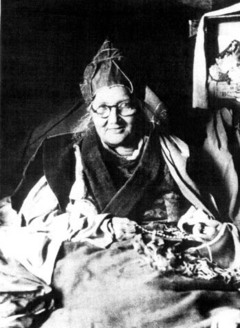Jetsün Lochen Guru Yoga
༄༅། །རྣལ་འབྱོར་དབང་མོ་རྗེ་བཙུན་ལོ་ཆེན་གྱི་བླ་རྣལ་བཞུགས།
Guru Yoga of Jetsün Lochen, Queen of Yoginīs
by Jamyang Khyentse Chökyi Lodrö
ན་མོ་ཛྙཱ་ན་ཌཱ་ཀི་ནི་ཡེ།
Namo jñāna-ḍākinyai!
རང་ངོ་ཤེས་པའི་ཕྱག་གིས་འདུད། །
In the homage of recognizing my own nature, I bow.
བྱིན་རླབས་མྱུར་དུ་འཇུག་པའི་སླད། །
བླ་མའི་རྣལ་འབྱོར་ཉུང་ངུ་དབྱེ། །
དེ་ལ་བདེ་བའི་སྟན་འཁོད་ནས། །
ངེས་འབྱུང་བྱང་སེམས་རྒྱུད་ལ་བསྐྱེད།
In order to inspire swift blessings,
I shall here set out a brief guru yoga.
For this, be seated comfortably
And develop renunciation and bodhicitta.
སྔོན་འགྲོ་སྐྱབས་སེམས་ནི།
Preliminary: Refuge and Bodhicitta
ཨ། བླ་མ་སྐུ་གསུམ་ལྷ་ཚོགས་ལ། །
a, lama ku sum lhatsok la
Ah. In the guru and three-kāya deities,
རང་ངོ་ཤེས་པས་སྐྱབས་སུ་མཆི། །
rang ngo shepé kyab su chi
Recognizing my own true nature, I take refuge.
གཟུང་འཛིན་སྣང་བ་རང་གྲོལ་ཕྱིར། །
zungdzin nangwa rangdrol chir
In order to self-liberate dualistic perception,
ཡེ་གྲོལ་ཆེན་པོར་སེམས་བསྐྱེད་དོ། །
yedrol chenpor semkyé do
In great primordial freedom, I generate bodhicitta.
ལན་གསུམ།
Repeat this three times.
དངོས་གཞི་ནི།
Main Practice
ཨ། རང་སྣང་རྣམ་དག་མདུན་དུ་མཁར། །
a, rangnang namdak dündu khar
Ah. In the utter purity of my own perception, in the sky before me,
དབྱིངས་སྣང་ལྷུན་གྲུབ་འཇའ་ཟེར་ཀློང་། །
ying nang lhündrub jazer long
In a visionary expanse of spontaneously rainbow-coloured light,
པད་ཟླ་ཉི་མ་བམ་རོའི་སྟེང་། །
pé da nyima bamrö teng
Upon lotus, moon, sun and corpse,
རྣལ་འབྱོར་རིག་འཛིན་གྲུབ་པའི་རྗེ། །
naljor rigdzin drubpé jé
Is the foremost yoginī and accomplished vidyādharā,
ཆོས་ཉིད་དབང་མོ་དཀར་དམར་མདངས། །
chönyi wangmo kar mar dang
Chönyi Wangmo, who is white with a reddish glow.
ཕྱག་གཡས་ཐོད་པའི་ཅང་ཏེ་འཁྲོལ། །
chak yé töpé chang té trol
With her right hand she plays a skull-bone hand-drum.
གཡོན་པ་མཉམ་བཞག་ཐོད་བུམ་བསྣམས། །
yönpa nyamzhak tö bum nam
Her left hand, in the gesture of equanimity, holds a skull-cup vase.
ཧེ་རུ་ཀ་དཔལ་ཁ་ཊཱྃ་འཆང་། །
heruka pal kha tam chang
The khaṭvāṅga, which she holds, represents the glorious heruka.
གཅེར་བུ་ཨང་རག་རུས་རྒྱན་གསོལ། །
cherbu ang rak rügyen sol
She is naked but for skirt and bone ornaments.
ཞབས་གཉིས་ཕྱེད་སྐྱིལ་རོལ་པས་འགྱིང་། །
zhab nyi chekyil rolpé gying
Her two feet are half-crossed in a posture of ease.
གནས་གསུམ་ཡི་གེ་འབྲུ་གསུམ་མཚན། །
né sum yigé dru sum tsen
Her three centres are marked with three syllables,
འོད་འཕྲོས་ཡེ་ཤེས་སྤྱན་དྲངས་ཐིམ། །
ö trö yeshe chendrang tim
From which light radiates out to invite the wisdom forms that merge with the visualization
དམ་ཡེ་དབྱེར་མེད་ཆེན་པོར་གསལ། །
damyé yermé chenpor sal
In the great inseparability of samayasattva and jñānasattva.
ཡན་ལག་བདུན་གྱི་ཚོགས་བསགས་ནི།
Accumulation through the Seven Branches
རང་རིག་བླ་མའི་ལྷ་ཚོགས་ལ། །
rangrig lamé lhatsok la
To the hosts deities of the guru who is my own awareness,
སྒོ་གསུམ་གུས་པས་ཕྱག་འཚལ་ལོ། །
go sum güpé chaktsal lo
I pay homage, with devotion in body, speech and mind.
དངོས་འབྱོར་ཡིད་སྤྲུལ་མཆོད་པ་འབུལ། །
ngöjor yitrul chöpa bul
I present actual offerings and those created in the imagination.
སྡིག་ལྟུང་སྐྱེ་མེད་ངང་དུ་བཤགས། །
diktung kyemé ngang du shak
In the unborn state, I confess my misdeeds and downfalls.
གཉིས་འཛིན་བྲལ་བས་རྗེས་ཡི་རང་། །
nyidzin dralwé jé yi rang
Free from dualistic perception, I rejoice.
གཞོམ་མེད་ཆོས་འཁོར་བསྐོར་དུ་གསོལ། །
zhommé chökhor kor du sol
Turn the indestructible Dharma Wheel, I pray.
འཕོ་འགྱུར་མེད་པར་བཞུགས་གསོལ་འདེབས། །
pogyur mepar zhuk soldeb
Remain, I beseech you, beyond transference and change.
དགེ་ཚོགས་གཞོན་ནུ་བུམ་སྐུར་བསྔོ། །
gé tsok zhönnu bumkur ngo
All accumulated virtues, to the youthful vase body I dedicate.
ཀུན་བཟང་གོ་འཕང་ཐོབ་པར་ཤོག །
kunzang gopang tobpar shok
May we attain the state of Samantabhadra.
ཅེས་དང་།
གསོལ་འདེབས་ནི།
Prayer
ཕྱི་ལྟར་རིག་འཛིན་ཆོས་ཉིད་དབང་མོ་ནི། །
chitar rigdzin chönyi wangmo ni
Outwardly, you are the vidyādharā Chönyi Wangmo;
ནང་དུ་དབྱིངས་ཕྱུག་བདེ་ཆེན་མཚོ་རྒྱལ་ཡུམ། །
nang du yingchuk dechen tsogyal yum
Inwardly, you are Tsogyal, queen of space, the lady of great bliss;
གསང་བ་ལྷན་སྐྱེས་རྡོ་རྗེ་རྣལ་འབྱོར་མར། །
sangwa lhenkyé dorjé naljormar
And secretly, you are the naturally arisen Vajrayoginī—
གསོལ་བ་འདེབས་སོ་མཆོག་ཐུན་དངོས་གྲུབ་སྩོལ། །
solwa deb so choktün ngödrub tsol
To you I pray: bestow supreme and ordinary attainments!
ལན་གྲངས་ཅི་ནུས་དང་།
Repeat this as many times as you can.
བསྙེན་པ་ནི།
Mantra Recitation
ཨོཾ་ཨཱཿགུ་རུ་ཛྙཱ་ན་ཌཱ་ཀི་ནི་སརྦ་སིདྡྷི་ཕ་ལ་ཧཱུྃ།
om ah guru jnana dakini sarwa siddhi pala hung
oṃ āḥ guru jñāna ḍākini sarva siddhi phala hūṃ
ཅེས་འགྲུབ་བཟླ།
ཐུན་མཐར་དབང་བླང་བ་ནི།
Conclusion: Receiving Empowerment
བླ་མའི་གནས་གསུམ་རྡོ་རྗེའི་འབྲུ་གསུམ་ལས། །
lamé né sum dorjé dru sum lé
From the three vajra syllables at the guru’s three places,
འོད་ཟེར་དཀར་དམར་མཐིང་གསུམ་རིམ་དང་ནི། །
özer kar mar ting sum rim dang ni
Emerge rays of light—white, red and blue—first in turn,
ཅིག་ཅར་བྱུང་བ་རང་གི་གནས་གསུམ་ཐིམ། །
chikchar jungwa rang gi né sum tim
Then all at once, which dissolve into my own three centres.
སྒྲིབ་དག་དབང་དང་དངོས་གྲུབ་ཐོབ་པར་གྱུར། །
drib dak wang dang ngödrub tobpar gyur
Obscurations are purified, I receive empowerment and accomplishment,
སྐུ་བཞིའི་ས་བོན་རྒྱུད་ལ་བཞག་པར་བསམ། །
ku zhi sabön gyü la zhakpar sam
And the seeds of the three kāyas are implanted within my mindstream.
མཐར་ནི་བླ་མ་དགྱེས་པས་རང་ལ་ཐིམ། །
tar ni lama gyepé rang la tim
At the end, the guru is pleased and dissolves into me.
དུས་གསུམ་རྟོག་པས་མ་བསླད་གཉུག་མའི་ངང་། །
dü sum tokpé ma lé nyukmé ngang
Untainted by thoughts of past, present or future, I remain in the genuine state,
རང་རིག་འོད་གསལ་ཆོས་སྐུའི་རང་ཞལ་བལྟ། །
rangrig ösal chökü rang zhal ta
And in the clear light of my own awareness, gaze into my own true face, dharmakāya.
ཞེས་བརྗོད་ལ་དགོངས་པའི་ངང་བསྐྱང་ངོ་། །
Recite these lines and sustain an experience of the wisdom mind.
དགེ་བ་བསྔོ་ཞིང་སྨོན་ལམ་གདབ་བོ། །
Dedicate the virtue and recite prayers of aspiration.
ཅེས་པའང་རྗེ་བཙུན་ཉིད་ཀྱི་ཞལ་སློབ་ངག་དབང་ཆོས་ཉིད་ནས་བསྐུལ་ངོར། འཇམ་དབྱངས་ཆོས་ཀྱི་བློ་གྲོས་པས་གངས་རི་ཐོད་དཀར་ཀུན་མཁྱེན་གཟིམ་ཕུག་ཏུ་སྨྲས་རིམ་བཞིན་རང་སློབ་འགྱུར་མེད་གྲགས་པས་བྲིས་པ་དགེ་ལེགས་འཕེལ།། །།
Thus, in response to a request from the venerable teacher’s disciple, Ngawang Chönyi, I, Jamyang Chökyi Lodrö dictated these words to my own student, Gyurme Drakpa, while we were in the Omniscient One’s cave at Gangri Tökar. May virtue and goodness increase!
| Translated by Adam Pearcey with the generous support of the Khyentse Foundation and Tertön Sogyal Trust, 2019.
Source:
'Jam dbyangs chos kyi blo gros. "rnal 'byor dbang mo rje btsun lo chen gyi bla ma'i rnal 'byor/" in ’Jam dbyangs chos kyi blo gros kyi gsung ’bum. 12 vols. Bir: Khyentse Labrang, 2012. W1KG12986 Vol. 4: 101–102
Version: 1.1-2024111
